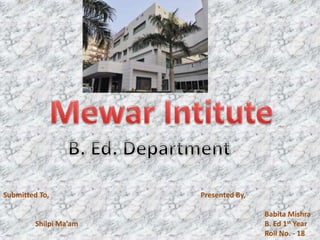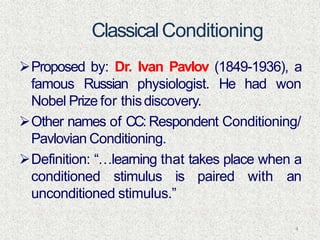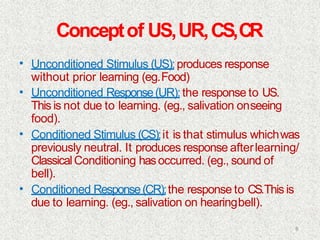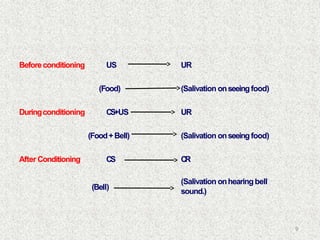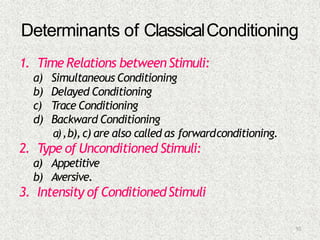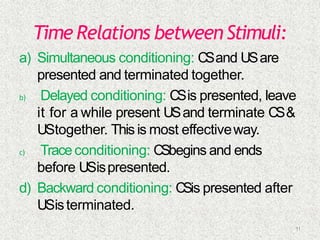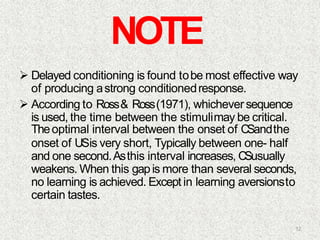Classical conditional theory dr. babita
- 1. Presented By, Babita Mishra B. Ed 1st Year Roll No. - 18 Submitted To, Shilpi MaŌĆÖam
- 3. Conditioning 3 ŌĆ£ŌĆ”aprocess by which people or animalsare trained to behave in aparticularway when particular thingshappen.ŌĆØ
- 4. ClassicalConditioning 4 ’āśProposed by: Dr. Ivan Pavlov (1849-1936), a famous Russian physiologist. He had won Nobel Prize for thisdiscovery. ’āśOther names of CC: Respondent Conditioning/ Pavlovian Conditioning. ’āśDefinition: ŌĆ£ŌĆ”learning that takes place when a conditioned stimulus is paired with an unconditioned stimulus.ŌĆØ
- 5. How Pavlov Discovered CC? 5 ŌĆó Actually Pavlov wasstudying the digestive system of dog. During his studies he noticed that his dogs,started secreting saliva assoon asthey sawthe empty plate in which food was served. ŌĆó Ideally, plate is not astimuli that is sufficient to activate hunger drive and secrete saliva.So he designed the experiment to seeif other neutral stimuli can also do the samejob.
- 6. TheExperiment 6 Setup: Dog is kept hungry on experimental table fitted with mechanically controlled devices observer is hidden from dog but he can see the dog through mirrors . Procedure: 1.Bell sound’āĀ Foodisproduced. 2.Dog’āĀ SeesfoodSalivates. 3.Step1 is repeated several times. 4.Bell Sound’āĀ DogSalivates.
- 8. Conceptof US,UR,CS,CR 8 ŌĆó ŌĆó ŌĆó ŌĆó Unconditioned Stimulus (US):produces response without prior learning (eg.Food) Unconditioned Response(UR):the response to US. This is not due to learning. (eg., salivation onseeing food). Conditioned Stimulus (CS):it is that stimulus whichwas previously neutral. It produces response afterlearning/ ClassicalConditioning hasoccurred. (eg., sound of bell). Conditioned Response(CR):the response to CS.This is due to learning. (eg., salivation on hearingbell).
- 9. Beforeconditioning US UR (Food) (Salivation onseeingfood) Duringconditioning CS+US UR (Food+Bell) (Salivation onseeingfood) After Conditioning CS CR (Bell) (Salivation onhearingbell sound.) 9
- 10. Determinants of ClassicalConditioning 10 1. Time Relations betweenStimuli: a) Simultaneous Conditioning b) Delayed Conditioning c) Trace Conditioning d) Backward Conditioning a),b),c) are also called as forwardconditioning. 2. Type of Unconditioned Stimuli: a) Appetitive b) Aversive. 3. Intensity of ConditionedStimuli
- 11. Time Relations betweenStimuli: 11 a) Simultaneous conditioning: CSand USare presented and terminated together. b) Delayed conditioning: CSis presented, leave it for a while present USand terminate CS& UStogether. This is most effectiveway. c) Traceconditioning: CSbegins and ends before USispresented. d) Backward conditioning: CSis presented after USisterminated.
- 12. NOTE 12 ’āś Delayed conditioning is found tobe most effective way of producing astrong conditionedresponse. ’āś According to Ross& Ross(1971), whicheversequence is used, the time between the stimulimay be critical. Theoptimal interval between the onset of CSandthe onset of USis very short, Typically between one- half and one second.Asthis interval increases, CSusually weakens. When this gapis more than several seconds, no learning is achieved. Except in learning aversionsto certain tastes.
- 13. Typeof Unconditioned Stimuli: 13 TheUSused in studies of CCare basically of two types: i. Appetitive USautomatically elicits approach responses, such as eating, drinking, caressing, etc. These responses give satisfaction and pleasure. ii. Aversive US such as noise, bitter taste, electric shock, painful injections, etc. are painful, harmful, and elicit avoidance and escaperesponses. Appetitive classical conditioning is slower and requires greater number of acquisition trials, but aversive classical conditioning is established in one, two or three trials depending on the intensity of the aversiveUS.
- 14. Intensity of ConditionedStimuli 14 ’āśThisinfluences the course of bothappetitive and aversive classicalconditioning. ’āśMore intense CSare more effectivein accelerating the acquisition ofCR. ’āśThemore intense the CS,the fewer arethe number of acquisition trials needed for conditioning.
- 15. 15

